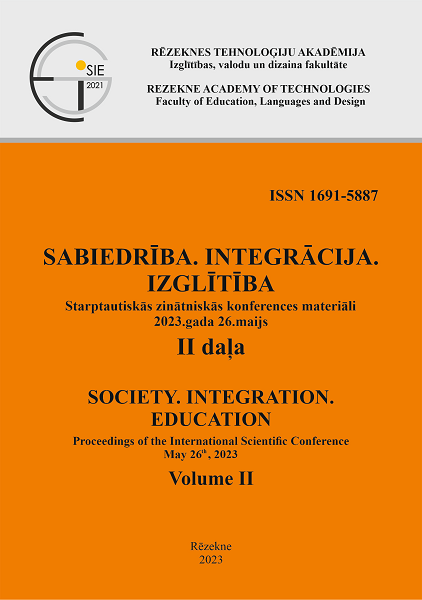VISUAL SEMIOTICS IN THE STUDY OF ART PHENOMENA: SYMBOL AND SYMPTOM
DOI:
https://doi.org/10.17770/sie2023vol2.7148Keywords:
cemeteries as a segment of the city, codes of ritual graphics, symbol and symptom, symbolization and desymbolization, visual semioticsAbstract
The study aims to use the approach of visual semiotics to analyse the ritual graphic signs of the Rezekne Jewish cemetery as a segment of the city in terms of "signifier" and "signified", or “expression” and “content”. The Star of David, as the dominant sign of the ritual graphics, is gradually losing the status of a sacred symbol and in a series of tombstones confirms the structure of a symptom. The paper is devoted not only to clarifying the cultural and social causes of such changes but also to the study of the mechanism of mutual transitions between symbols and symptoms, the differences in the coding of these types of signs, which has not been done in visual semiotics so far.
Theoreticians have hitherto not paid due attention to the study of signs of graves as a segment of the urban environment. Moreover, the theory of visual semiotics also lacks a description of the specificity of signs in ritual graphics. Ritual graphics is an important indicator of the regularity of cultural processes in an ethnically diverse environment. When surveying the Jewish cemeteries of the Latgale region, the difference in the choice of visual graphics in the city and the countryside is obvious. In rural cemeteries that are still in use, the content and structure of verbal messages, as well as decorative graphics are traditional, therefore predictable. In city cemeteries, there is a change in graphics, deviations from tradition, its modification and obvious violations of tradition. Along with the verbal report about the deceased, the ritual graphic, on the one hand, complements it as an integral part, on the other hand, lives an independent life, because the first, and the only sign that the observer notices is the visual or non-verbal sign. In terms of information, the visual sign is noticeably more capacious, as it is older than the verbal and requires much less time for perception. The focus of the study is the divergence between the meanings of the sacred hexagram and the secular yellow star or “badge”, the causal relationships of their use and perception from the point of view of visual semiotics and cultural philosophy - phenomena of symbolization and desymbolization.
References
Arnheim, R. (1957). Film as art. Berkeley: University of California Press.
Barthes, R. (1957). Mythologies. New York: Hill & Wang.
Bart, R. (1994). Izbrannyje statji. Semiotika. Poetika. Moskva: Progress, Univers.
Chandler, D. (2000). Semiotics for Beginners. Aberystwyth: University of Wales.
Eco, U. (1976). A Theory of Semiotics. Bloomington: Indiana University Press/London.
Eko, U. (2006). Otsutstvujuščaja struktura. Vvedeņije v semioloģiju. Perev. V. Rexznik, A. Pogoņajlo, Sankt-Peterburg: symposium.
Lotman, J. (1992). Semiotika kuļtury i poņatije teksta. J. Lotman. Izbrannyje statji. T. 1. Tallinn: Aleksandra, 129-132.
Lotman, J. (1992). Simvol v sisteme kuļtury. J. Lotman. Izbrannyje statji. T. 1. Tallinn: Aleksandra, 191–199.
Melers, M. (2006). Ebreju kapsētas Latvijā. Rīga: Šamir.
Noeth, W. (1995). Handbook of Semiotics. Bloomington: Indiana University Press.
Saussure, F. de (1983): Course in General Linguistics. Trans. R. Harris, London: Duckworth.
Senkāne, O. (2017). Latgales ebreju kapu kultūra semiotiskā aspektā. No U. Neiburgs (red.), Uldis (red.). Ebreju Rēzekne. Rīga: Creative Museum.79–197.






